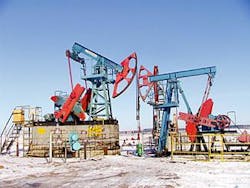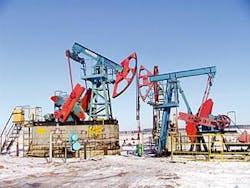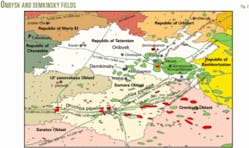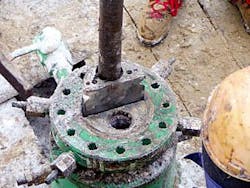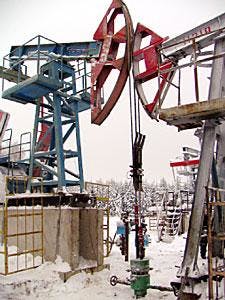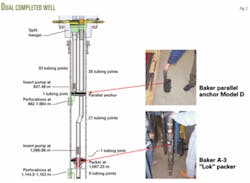Dual completion technology allowed a joint venture in Russia to accelerate production, add reserves, reduce costs, and still comply with Russian regulations requiring zones to be produced separately.
The dual completions in the two wells, worked over in December 2004, involved the installation of two tubing strings in a single production casing string so that separate artificial lift systems can produce zones individually (Fig. 1).
These completions possibly were the first dual-completed onshore wells in Russia, although completing wells with dual tubing strings has been a common practice in the US since at least the 1950s.
Devon Energy Corp., 50%, and OAO Tatneft, 50% are the owners of the ZAO Tatex joint venture that operate these wells. ZAO Tatex is one of the oldest joint ventures in Russia. It operates the Onbysk and Demkinsky fields in the Republic of Tatarstan, a part of the Russian Federation (Fig. 2).
Production from Demkinsky started in 2000 and its current production is 3,400 bo/d from 77 wells. The older field, Onbysk came on line in 1992 and currently produces 6,300 bo/d from 276 wells.
Technology transfer
In 2003, the joint venture began studying dual completion technologies as applied in the US. The main goal was to transfer US know-how to projects in Tatarstan.
It should be stressed that this was a team effort among partners, with each stakeholder making contributions that aided this effort. Tatneft, for example, lent assistance in design and logistics to expedite the project under the management of Nail Ibragimov, chief engineer and Rais Khisamov, chief geologist. From the US side, Devon Energy applied its in-house expertise throughout the design and installation stages under the supervision of the author, Rick Mitchell, director of drilling and construction, and Sergey Faerman, Devon's Russian country manager.
Also Tatex, which has a competent team of petroleum professionals led by General Director Irek Khairullin and Deputy General Director Rezit Minebaev, provided the internal resources and field management needed to conduct the work.
The following four primary reasons led to the introduction of this technology in Russia:
1. Need for independent reservoir management of each producing zone, in accordance with Russian regulations.
2. Booking of reserves additions, in accordance with US Security Exchange Commission (SEC) guidelines.
3. Acceleration of production.
4. Reduction of costs.
Reservoir management
According to Russian regulations, a company must categorize development objectives for each producing zone on the basis of similar lithologic characteristics, reservoir properties, formation fluids, and reservoir pressures. This requires that operators isolate each zone from other zones for reservoir pressure maintenance, production optimization, and data acquisition.
In accordance with these rules, operators can carryout simultaneous production from two or more zones in the same well only if they install subsurface equipment that provides for separate registration of flow rates, water cuts, formation pressures, and flowing bottomhole pressures. In this manner, the government strives to ensure a safe operation in which each producing zone is produced efficiently to maximize recovery and flow rates.
These rules led the joint venture to investigate technologies that would allow the development of two zones in a single wellbore.
This investigation included the study of multiple-packer combinations with sliding sleeves, dual packers with dual pumps, dual completions, and additional infill drilling.
null
null
For example, in accordance with the Ministry of Energy's guidelines on acquiring geophysical, hydrodynamic, and geochemical surveys, overseen by the State Committee of Tatarstan Republic On Geology and Subsurface, for each producing zone operators must:
- Test twice monthly all wells with a flow rate less than 5 tonnes/day (±36 bo/d) and weekly all wells with a flow rates greater than 5 tonnes/day.
- Measure water cut for each zone twice monthly if less than 2% or weekly if greater than 2%.
- Measure semiannually the reservoir pressure (such as the static fluid level).
- Obtain monthly the bottomhole pressure.
In Tatarstan, typically the following four zones comprise the development objectives:
1. Upper Carboniferous-mainly the Vereysky and Bashkirsky formations.
2. Middle Carboniferous-mainly the Tulsky and Bobrikovsky formations.
3. Lower Carboniferous-mainly the Turneysky subdivided into the Kizelovsky and Upinsky formations.
4. Devonian-mainly the Kinovsky and Pashiisky formations.
Thus, wells with oil-bearing seams in the Lower Carboniferous Kizelovsky and Upper Carboniferous Vereysky formations require the testing of individual zones for flow rate, pressure, and water cut according to the schedules in the regulations.
Of the four technologies evaluated, the investigation found that only dual tubing completions would allow the independent development of two objectives in the same wellbore while allowing the operator to properly manage each reservoir in an economic manner while acquiring the appropriate data.
Upon further study of Russian regulations, however, testing requirements added another challenge to finding an acceptable technology.
Tatex has dozens of wells with pay behind the pipe in the Middle and Upper Carboniferous horizons. It is of course technically possible to drill a second or third grid of infill wells to develop these reserves, but this is uneconomic at current drilling costs and the low initial oil producing rates from these zones.
During the last 4 years in Tatarstan, for example, drilling costs for wells with an average 1,300-m depth have risen to $300,000/well from $110,000/well.
Moreover, with the high viscosity oil and low permeabilities in the fields, the newly drilled wells produce only an average 2.5 tonnes/day (18 b/d).
Production acceleration
Local practice tends to delay the development of the upper horizons until the depletion of the lower horizons. In our business, however, cash flow plays a central role in any project. If a company has the potential to increase its production from a well while efficiently managing its reservoirs, why not do so if it is economically justified?
In the cases of the first two dual completions, production doubled on the first well to 6 cu m/day from 3 cu m/day, and on the second well, it increased to 31 cu m/day from 25 cu m/day previously.
The work in both wells will pay out in about 2 years.
The evaluation of the economics for drilling another grid of wells determined that most of the Middle and Upper Carboniferous prospects would never obtain a positive cash flow at current drilling costs and the expected low producing rates. Only dual-completion technology provided a positive cash flow. Thus, rising drilling costs have limited severely the option of drilling Lower, Middle, and Upper Carboniferous well grids.
Reserves additions
On a periodic basis, publicly traded US oil companies analyze and audit their reserves with the assistance of independent auditors. This is an extremely important activity because it provides the company with an indication of how many years of production it can expect from its fields and whether it can continue to be an ongoing entity. The company, moreover, publicly reports these reserves to investors through reserves recognition accounting that provides a key indicator for shareholders on the value of their investment.
In recent years, the US Security and Exchange Commission (SEC) has become increasingly stringent regarding the methods used to audit reserves.
null
The Society of Petroleum Engineers defines proved reserves as "Proved reserves are those quantities of petroleum which, by analysis of geological and/or engineering data, can be estimated with reasonable certainty to be commercially recoverable, from a given date forward, from known reservoirs and under current economic conditions, operating methods, and government regulations." Under this definition, a company cannot consider behind the pipe pay as proved reserves if there are no plans to develop them in the near to mid term.
These dual completions, therefore allow the joint venture to meet Russian regulatory guidelines for reservoir management as well as SEC standards for reserves recognition.
Well design
The two-wells selected for the dual completions were Turneysky formation completions, had minimal dogleg severities, and contained potential pay in the Bashkirsky horizon in one well and the Bobrikovsky horizon in the other well. Fig. 3 shows the downhole completion.
The most problematic engineering aspect in designing the dual completions involved the geometric relationships of the tubing coupling and seating nipple sizes in order to maximize clearance inside the production casing. In Tatarstan, for example, producers typically run 73-mm (27/8-in.) OD tubing with 89-mm (31/2-in.) couplings inside 153-mm (65/8-in.) ID production casing. Running dual strings of this tubing, therefore, was not possible.
Another common tubing size in the area is 60-mm (23/8-in.) OD tubing with 73-mm couplings. A dual string of this tubing would result in a 7 mm clearance. But with well deviations in the range of 15-45°, it was felt that the tubing strings would bind up while running in the hole.
To increase the clearance, Tatex turned down the 73-mm couplings to 69-mm and ran a tensile stress test on several joints. The stress tests showed that when the couplings are tightened properly, the weakest part of the string was the tubing body and not the turned-down coupling.
The use of this option doubled the clearance to 15 mm, which was deemed technically feasible.
Other components of the completions included:
- Baker Oil Tools retrievable "Lok" packers to hold the long string under 4.5-tonne tension.
- Baker Oil Tools parallel anchors and J-latches that could hold the short string under tension and easily be latched and unlatched whenever necessary.
- Cooper-Cameron Corp. dual wellheads to hang off both tubing strings.
- Harbison-Fischer Manufacturing Co. side-by-side stuffing boxes and flow tees designed specifically for dual completions (Fig. 4).
- High quality Harbison-Fischer RWBC rod pumps manufactured to ensure expected production rates and longevity under heavy oil, sulfurous conditions.
- Insert-pump seating nipples on the short-string side with less than a 69 mm OD. Domestic Russian seating nipples have an 89-mm OD, too large for the installation in a dual completion, so that the completions required the use of Harbison-Fischer's special clearance seating nipples. In an effort to allow the use of Russian pumps, Izhneftemash JSC currently is working on reducing its seating nipple ODs to the required diameters.
- Equipment needed to measure flow rates, downhole pressures, and water cuts. For example, this included the installation of Russian mass flowmeters manufactured in Bugulma.
- Lufkin Industries Inc. pump-off controllers to help optimize the pumping system.
- Surface layouts to accommodate two Izhneftemash pumping units while ensuring enough room to conduct workovers on adjacent wells.
Installation procedure
The basic installation procedure consisted of the following seven steps:
1. Run the long string with the packer, seating nipple, and parallel anchor to project TD. The tubing with the 73-mm couplings was run below the parallel anchor and the tubing with the 69-mm couplings was run above the parallel anchor.
2. Inflate the packer, space out, and hang the tubing under 5 tonnes of tension on the split hanger (Fig. 5).
3. Run in the short string with 69-mm couplings to the parallel anchor, reciprocating the tubing every 5 joints. This reciprocation serves to alleviate any wrapping tendencies that the short string may have around the long string.
4. J-latch into the parallel anchor, space out, and hang the short string under tension on the other side of the split hanger.
5. Install the pumps, polished rod, stuffing boxes, and flow lines.
6. Bridle up the pumping units and modify the surface equipment as necessary to ensure that the horseheads do not collide with one another. A deflection plate helps prevent interference between the pumping units (Fig. 6).
7. Install mass flowmeters and pump-off controllers to monitor pumping efficiencies, production rates, and pump intake pressures.
The work encountered no operational problems and was within the budget of $170,000/well. The installation required only 3 days on each well and encountered minimal down time, which is a credit to the preplanning effort of the personnel who worked on the project.
Based on a presentation to the OGJ Russia Petroleum Technology Forum, Mar. 9-11, 2005, Moscow.
The author
Dean E. Gaddy [Dean.Gaddy @dvn.com] is an operations superintendent for Devon Energy Corp. Located in Almetyevsk, Russia for the past 4 years, he oversees the company's drilling, completions, production, and sales activities. Previously he has worked as a geologist, driller, and in operations in the US, China, Australia, and Russia. Gaddy holds a BA in geology from the University of Northern Colorado and an MBA in technology management from the University of Phoenix. He is author of An Introduction to GIS for the Petroleum Industry, published by PennWell Corp.
